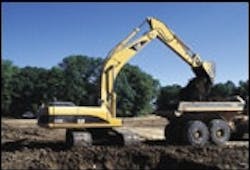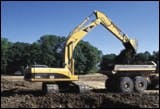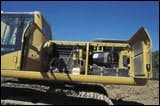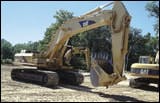Caterpillar's 330C Excavator Design Targets Tool Control
For the trenching test, each operator ran both machines for 30 minutes, creating trenches that averaged nearly 12 feet in depth and 4.3 feet in width. The material at the Proving Ground was heavy, moderately moist clay, estimated at around 3,500 pounds per bank cubic yard.
The 330B operated in its Power-Up (full-speed) power mode and in its Boom-Priority work mode. The 330C, of course, has no power- or work-mode buttons, and adjusts its hydraulic-horsepower output based on operator input at the control levers.
From data collected during the test runs, we projected per-hour production and fuel-consumption rates for each machine, based on the averaged performance of both operators. As the accompanying table indicates, the 330C was much the superior trencher, while also delivering better fuel efficiency. Note that bucket-fill ratios were identical, meaning that the new model's production advantage resulted essentially from its greater speed.
With more horsepower and greater hydraulic flow, the 330C moved the bucket more rapidly through the cut and lifted the payload faster. This capability, combined with faster swing acceleration, gives the new model a significant cycle-time advantage.
Trenching Comparison table
For the truck-loading comparison, each operator used both machines to five-pass load eight 30-ton-capacity articulated dump trucks. The excavators dug from material remaining between the cuts made in the trenching comparison, then swung 90 degrees to the truck. The 330C turned in a production advantage of nearly 13 percent, the result of faster cycle times and a better bucket-fill ratio.
As in the trenching test, the new model's increased horsepower and greater hydraulic flow resulted in more rapid bucket loading. In this application, the 330C's greater swing torque and faster swing acceleration was especially valuable in trimming its cycle time. This test also revealed the new model's ability to more efficiently load a larger bucket.
Truck-loading Comparison table
To measure the swing force of the test machines, we attached a cable to the tip of the digging arm (positioned near the ground), installed a electronic load cell along the cable's length, then anchored the cable's other end to another machine. The operator then swung gently to tighten the cable, then moved the control lever to its full-swing position with the engine at high idle (and with the "swing-priority" work mode engaged in the 330B). We repeated this procedure several times for each test unit, each time noting the highest reading on the load cell's remote readout panel. Averaging the results for each machine yielded the numbers in the accompanying table.
The 330C's greater swing force allows it to swing with increased power and speed, resulting both in faster cycle times (as indicated by the trenching and truck-loading tests), and in the capability to swing heavier loads uphill.
The 330C's swing motor's displacement (the amount of fluid the motor uses per revolution) has been increased by about 7 percent, and its torque is up an equivalent amount. Pressure in the swing circuit also has been modestly increased. Taken together, these refinements, coupled with the swing motor's gearing system, boost the 330C's overall swing torque about 12 percent.
Comparing Swing Torque table
In early September, Construction Equipment editors worked with Caterpillar to compare the basic dirt-moving capabilities and fuel economy of the new 330C-L hydraulic excavator with those of the machine it replaces, the 330B-L. To give you the thumbnail version here, the 330C was 11 percent more productive at trenching, with 10 percent better fuel efficiency, and approached a 13-percent edge at truck loading. Impressive numbers, these, the result of a fundamental design overhaul that gives the 330C more power, greater hydraulic speed and more precise electronic control.
Introduced in the mid-1990s, the Cat 330B hydraulic excavator, with a nominal operating weight of 76,000 pounds, earned a reputation among operators as a strong machine, particularly capable when pulling through really tough digging, handling trench boxes, and lifting. So, not wanting to meddle with success, Caterpillar was careful to preserve this brute strength in the new model and, in fact, gave the 330C an added 25 horsepower. The new machine is rated at 247 net horsepower @ 1,800 rpm, compared to the 330B's 222 horsepower at the same speed.
This added power comes from a brand new 8.8-liter Cat engine, the C9, which complies with the Environmental Protection Agency's Tier-2 emissions standard. The C9 features Caterpillar's hydraulic/electronic unit injectors (HEUI) and uses an air-to-air (charge-air) intercooler, both of which contribute to the new engine's more efficient use of fuel, as we saw demonstrated in the test.
The 330B's engine, equipped with a jacket-water intercooler, used engine coolant to reduce the temperature of air coming from the turbocharger. By comparison, the 330C's charge-air system, which forces ambient air across its cooler, is more effective at lowering air temperatures in the combustion chambers, which, in turn, reduces the formation of nitrogen oxides and particulate matter for a cleaner exhaust.
Complementing the new machine's cleaner, more powerful engine is a 17-percent boost in hydraulic flow. Although both machines use similar implement hydraulic systems (open-center, two-pump, negative-flow types), tweaking the 330C's system has significantly increased the new model's digging speed. According to Cat, boom, digging arm and bucket movements are increased from 5 percent (arm in) to 28 percent (boom down).
Overall cycle speed is further enhanced by a 12-percent increase in swing torque. This refinement not only gives the 330C more swing power on slopes, but also allows it to accelerate faster (by 4 to 6 percent, says Cat) when swinging from trench to spoil pile or truck. Our testing showed an average cycle-time advantage of more than 9 percent for the new machine.
Caterpillar also has made a significant change in its hydraulic-control philosophy with the 330C (and with all other models in its new C-Series). Essentially, the 330C relies on its own electronic intelligence to prioritize hydraulic flow. It does this by analyzing the operator's movement of the joystick controllers, then adjusting hydraulic flow and power to match the perceived application.
What this means in the cab, of course, is simplified control, because the buttons for selecting power modes (engine speeds) and work modes (hydraulic-flow priorities) are no longer required. By contrast, the 330B operator had to select a power mode, either full or economy, and one of four work modes to match hydraulic characteristics to the application.
Caterpillar's Peoria Proving Ground, the site for the test, has some of the best soil around for running production comparisons, because every time the ground is used, the disturbed material is removed and stockpiled, then replaced and compacted layer-by-layer. The result is a clean soil that is uniform in consistency and density—and that holds no surprises, such as rocks or stumps, that can foul up the accuracy of a trenching test.
Caterpillar's Dan Wienkes, senior product consultant, and Evan Creson, excavator-marketing division, handled the logistics of arranging the field test and were on site with CE editors. Also assisting on site were Dave Tallon and Bodie Hodge, both machine development engineers at the Peoria Proving Ground. Operators for the test were Ron Hiett, on staff at the Proving Ground, and Ron Fauber, an operator at Caterpillar's Edwards Demonstration Facility.
The 330C test machine was a virtually new unit (84 hours) in Caterpillar's demonstration fleet. The 330B was a rental with 3,075 hours. Prior to the test, Proving Ground technicians made engine-power checks and hydraulic-flow and pressure checks to assure that both machines were running in their correct specification range.
Both units were fitted with Cat's reach boom (21 feet 4 inches) and with comparable digging arms, measuring 10 feet 10 inches for the 330B and 10 feet 6 inches for the 330C. For the trenching comparison, the same heavy-duty bucket, rated at 1.6 cubic yards, was switched between the two machines, as was the 2.5-cubic-yard bucket used for the truck-loading test. Both machines were equipped with 34-inch shoes.
Fuel consumption numbers were collected via auxiliary tanks fitted to both machines. The tanks were removed, filled and weighed before each test run, then again removed and weighed at the conclusion of the run. The auxiliaries were designed with a switching valve that allowed using main-tank fuel while doing non-test maneuvering.
The 330B, of course, offers practical attachment control via its optional auxiliary-hydraulic system, which, like the 330C, includes a standard auxiliary spool in the main valve. The 330C, however, is much superior to its predecessor in its ability to precisely control attached tools. Expanded and refined attachment handling, in fact, was a key design objective for the new model.
At the heart of the new machine's auxiliary hydraulic system is an easily expanded main valve, which allows stacking on three additional valve sections, which are either a parallel-circuit type (providing two-pump combination flow), or an auxiliary-pump-circuit type (accommodating a third pump). The latter type is ideal, says Cat, for powering rotating tools and generators used with electromagnetic attachments. The stackable design of the 330C's main valve virtually eliminates the need to install remote-mounted valves, as is sometimes required with the 330B.
If the 330C buyer has need for auxiliary hydraulics, the machine can be ordered with one of three optional control packages. The simplest is a "hammer package" (a single-function circuit using two-pump flow in one direction) that is ideal for hammers or compactors, says Cat. The "thumb package" (a double-function circuit using one-pump flow in two directions) is designed for thumbs and tilt buckets.
But the ultimate for handling attachments with the 330C is the new Tool Control System (TCS), which electronically controls the stackable-valve system and allows programming up to five parameters (including flow, pressure, engine speed and number of pumps) for frequently used tools. These presets can be conveniently selected from the electronic controller through the monitor and, in addition, the system provides modulated control of attachments, not just on/off capability.
Another big change for the 330C is its cooling package. Caterpillar relocated the 330C's hydraulic-oil cooler and air-conditioner condenser to a separate compartment just behind the cab on the left side. That leaves the radiator and new charge-air cooler in the adjacent rearward compartment. (The 330B had its oil cooler, radiator and condenser stacked together in the single rearward compartment.) Separating these heat exchangers, says Cat, promotes more efficient cooling and simplifies cleaning.
According to Cat, the 330C's cooling efficiency is enhanced also by the design of its new oil cooler. Although overall core size is smaller than that of the 330B, the new cooler's material and fin shape, according to Cat, actually promote a 12-percent gain in cooling efficiency.
Cooling capability is critical for good design, of course, but we're always also impressed by seemingly small engineering refinements that make a difference in a machine's character. Such is the greased and sealed track on the 330C. Although the 330C's track pins don't have oil reservoirs as do "lubricated" tracks, the pins and bushings are assembled with grease, which is retained by newly developed, more flexible seals. Granted, the 330B with its "dry" tracks had 3,000 hours on the meter, but the 330C's tracks were so much quieter that the difference was dramatic.
Another unobtrusive design detail for the 330C is its reinforced cab structure, which allows optional guarding (such as that for demolition applications) to be easily installed at the factory or as an after-market add-on. Adding such guarding on the 330B, in most instances, would require first reinforcing the basic structure. The new model's cab shell also uses new structural members designed to improve resistance to fatigue and vibration.
The 330C's cab interior also has a freshened design. Switches and controls are grouped together on the right console (key and throttle dial) and on the sill of the right-side window. The consoles have been redesigned, now higher with integral armrests, the seat incorporates two types of cushion hardness to lessen fatigue, the right window is larger, as is the skylight, and relocated air-conditioning vents direct more flow at the operator.
The cab's new monitor is smaller, allowing more knee room, and its liquid crystal display presents text messages in as many as 20 languages. You can track the number of hours on fluids and filters through the monitor, and also receive a reminder when hours are approaching the service interval preset by the user. In addition, says Cat, 330C electronic systems allow tracking working hours on the engine, main pumps and travel motors, and this information is available at the monitor.
Routine service also has been streamlined on the 330C, with the fuel filter (now 2-micron capacity, compared to the 330B's 7-micron), water separator and engine-oil filter relocated for easy ground-level service. Easily removable screens protect heat exchangers from clogging and facilitate cleaning. Front-linkage pins (except for the bucket) now require grease only at 1,000-hour intervals, and the oil-change interval has been extended to 500 hours. The new model also is "Product Link ready," allowing easy installation of a GPS-based location and maintenance-monitoring system.
Our test operators, Ron Hiett and Ron Fauber, agreed that both the 330B and 330C felt quite powerful digging in the heavy, tightly compacted soil at the Proving Ground. But the fundamental performance difference between the two machines, in their collective opinion, is speed—faster through the cut, faster out of the hole and faster to and from the spoil pile.
And from the operator's point of view, says Fauber, you really have to appreciate the improved attachment control available with the Tool Control System, which allows calling up exact operating parameters from the in-cab monitor. The system, he says, eliminates weak performance from attachments that aren't supplied with adequate flow and pressure, and also eliminates the risk of destroying tools that are overpowered.
Overall, says Fauber, the 330C is a more powerful machine that adds refinement to its predecessor's open-center hydraulic system, which, he says, already possessed a smooth responsiveness. New operators should find the 330C's hydraulics extremely friendly, he says, and experienced operators should appreciate the 330C's refined controllability and enhanced multi-function capability.







